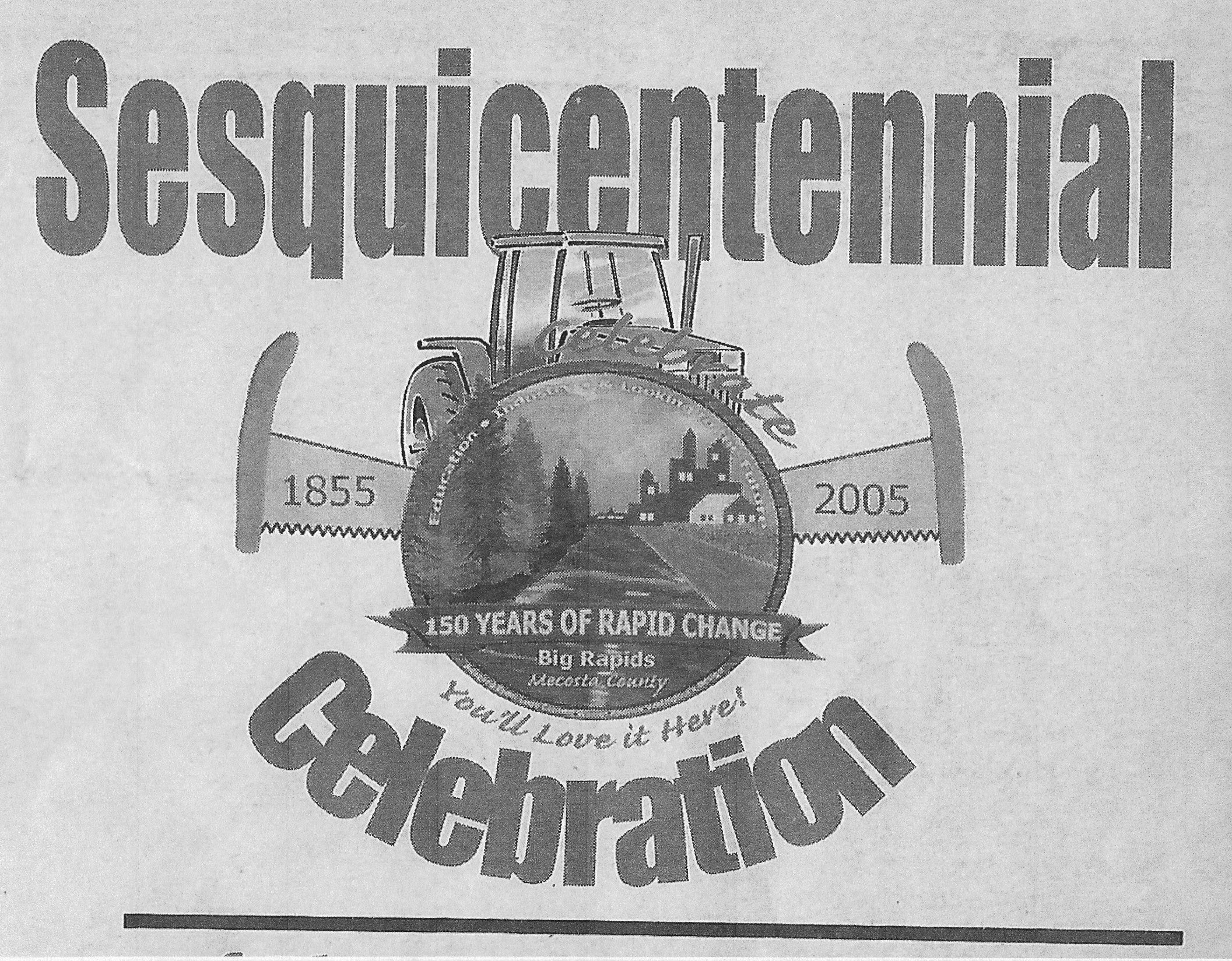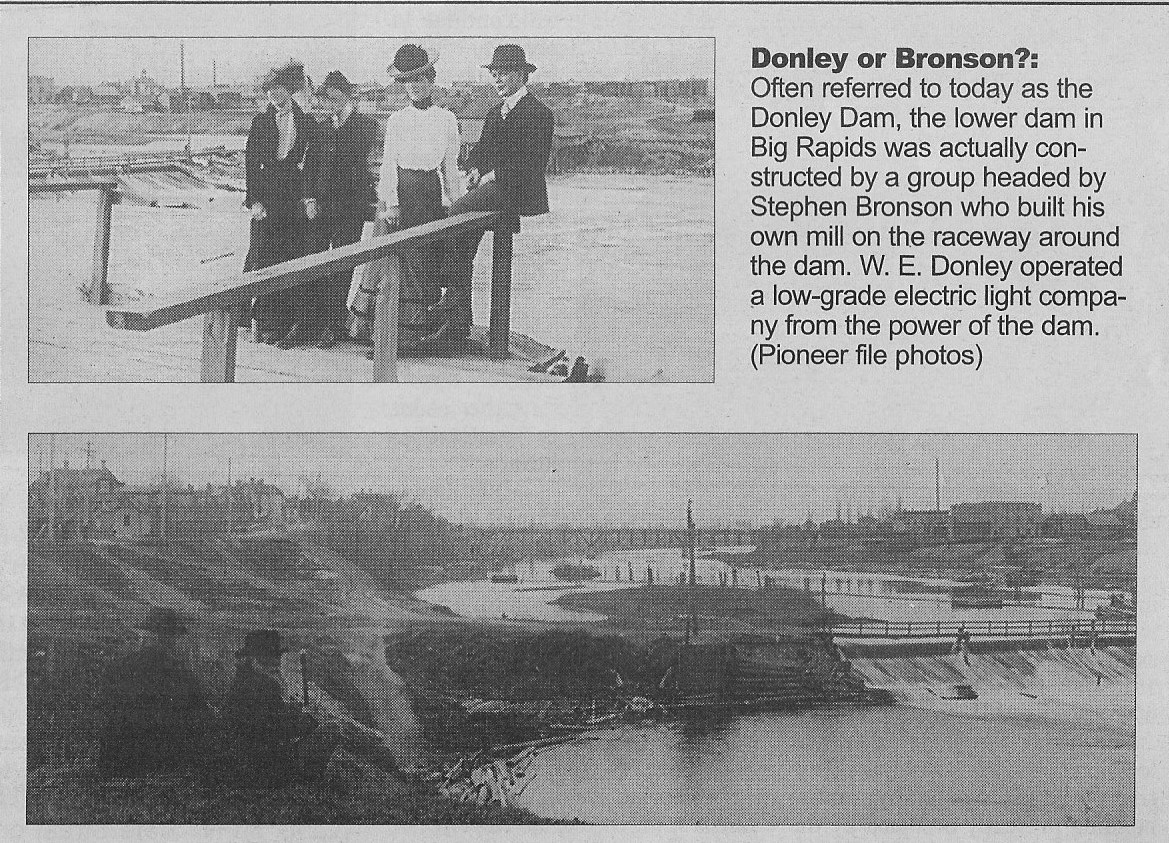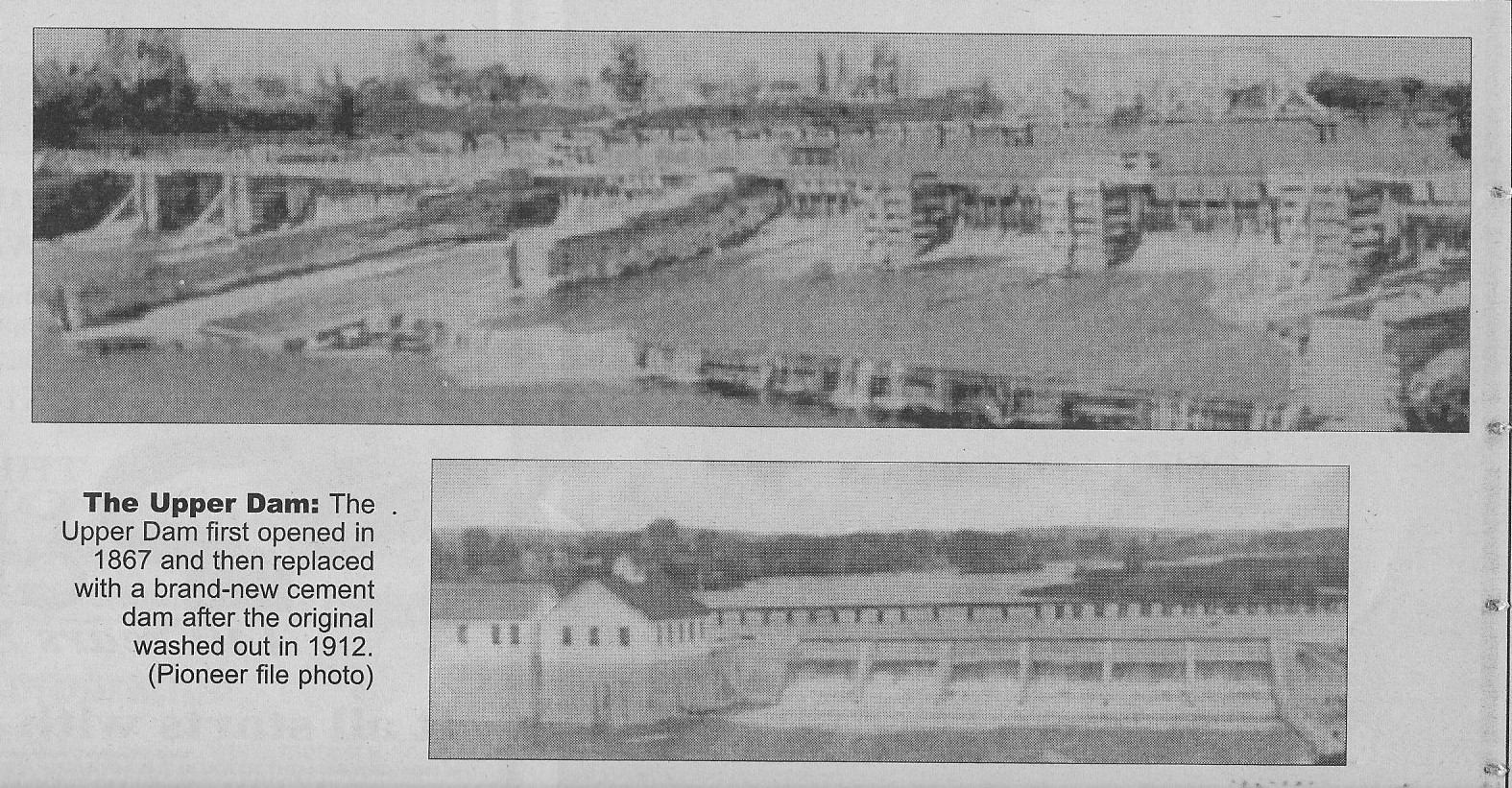
Part V - Government, a supplement to the Big Rapids Pioneer Newspaper. Used with permission.
By Jim Bruskotter - Managing Editor

The Muskegon River lent more than just a name to the community at the big rapids. The swift currents passing through the fledgling community of the 1860's provided the initial power to turn the turbines, cylinders and shafts that powered the saws to cut the wood used to build a city of over 6,000 in less than three decades.
Whike the mechanical power of the river had to compete with improved steam power operations in but a few short years, residents of the area turned to the river again for power when they harnessed the hydroelectric forces of the river at the two dams in Big Rapids and later at a third dam just five miles downstream.
It all started in September of 1866 when construction began on an earth, timber and stone dam just north of the present day Baldwin Street Bridge.
Under the direction of a company formed by Fred H. Todd, the dam was completed in the middle part of 1867. Less than a year later in March of 1868, Todd drowned after slipping and falling intio the backwaters while inspecting the dam.
The senior partner of Todd's company, multi-millionaire John F. Brown, then moved to Big Rapids from Tioga County, N.Y. and took over management of a company that was renamed Tioga Manufacturing.
The company would flourish under Brown's leadership and the boon time was under as industrial firms sprung up along the millraces on both sides of the river.
Bolstered by the success of the uper dam, the George B. Warren, Bronson and Stickney Company erecyed a second dam at the foot of Linden Street, just below the Maple Street Bridge in 1870.
The firm erected a raceway 100 feet wide and 700 feet long on the east side of the river with expectations of more industrial firms lining up to utilize the race to power their companies.
But, when T.D. Stimpson, who also built a multi-million dollar empire, opened his huge mill just north of the dam in 1871, he turned to steam power and the lower race never gained the popularity of the upper receways. Steven Bronson's mill was the only firm to utilize the lower dam's raceway for power and the dam never proved profitable.
In the early 1890's Ferdinand Fairman introduced DC power to the city by installing a small generating plant at the upper dam while his son0in0law Edward W. Hudnutt did the same at the lower dam in 1892. The dynamos installed at the lower dam provided enough DC power for 12 incandescent city street lights.
Hudnutt removed one of two dynamos from the lower dam to the upper dam when the former succumbed to summer floodwaters in 1897. Hudnutt and the second dynamo to W.E. Donley whose electric Light Company continued to provide a limited amount of DC power for the city's street lights until a fateful day in January of 1906 when the lower dam was washed away for ever.
Portions of the lower dam are still visible in the river when its waters are clear, according to longtime city employee Roger Schneidt.
The city then went without electric lights until November of 1906 when power was extended from the brand new Rogers Dam which had incurred a series of accidents and sabotage shortly after opening in the summer of the same year.
The Mecosta County Board of Supervisors had granted approval in 1902 to the Grand Rapis-Muskegon Power Co., to construct three dams below Big Rapids, including Rogers Dam.
The company really had no intention of providing power to Big Rapids as the city's dams and raceways put it on par with any other city in Michigan at that time.
But, when the ice jams and floodwaters washed away the lower dam in January of 1906 and seriously damaged the upper dam, the Grand Rapids-Muskegon Power Company aagreed to extend power for the city's lights and more, including industrial, business and residential usuage.
The friendly status between the new power company and the County Board of Supervisors disintegrated in 1909 when the supervisors , upset over the company's failure to build the second and third dams approved bck in 1902, ordered the power company to remove Rogers Dam.
The second dam was supposed to have been constructed just north of where Eight Mile Road now crosses the river while the third dam was proposed to cross the river at a location where the Muskegon passes through the northwest corner oif Aetna Township.
The supervisors theorized that the county was being cheated out of additional tax revenues and economic growth and that the power company was attempting to monopolize all power in the county.
The Michigan Supreme Court ruled in January of 1910 that a county could not rescind permission once a dam was constructed.
Rogers Dam is still producing power today on the verge oif celebrating a century of usuage in 2006.
In 2000 and 2001 Big Rapids, state and federal forces joined hands in a project to remove the remains of the old upper dam in Big Rapids after failed attempts to blow it out in 1966.
Ed Sanderson, a native of Big Rapids who has lived on the east side of the river behind the old dam site his entire life, claims there are still portions of the old dam in and along the river.
The dam had continued to operate from 1867 until 1955 under various coalitions of business, industrial and governmental partnerships, first as the earth, timber and stone dam constructed by Todd's company and later as a large larger cement dam built by the Big Rapids Electric Company after floods carried away the first structure in 1912.
The new cement structure was built on the same base used for the original dam with a much larger head, but the new structure in Big Rapids still did not compare in size to the monstrosity built down river just a few years earlier.
Noiw, the upper dam has been removed and the river has been returned to its natural state. similar to what early settlers found when they came to the area in the 1850's.
AWnd the remaining dams owned by Consumers Energy at Rogers, Hardy and Croton play a very minor role in the overall power grid for the state.
But, from 1866 to 1955 dams in and just downstream from Big Rapids were important catalysts for industrial, commercial and residential development of the area.
Today the old dams in Big Rapids are more historical notes to a newly developed Riverwalk along the city's banks as the river's prime function now is to fulfill the recreational needs of residents and tourists alike.
But the records of the past serve as reminders that the river was once the prime catalyst to the development of the city on the rapids.


Return to Mecosta sesquicentennial Page
Return to Home Page




